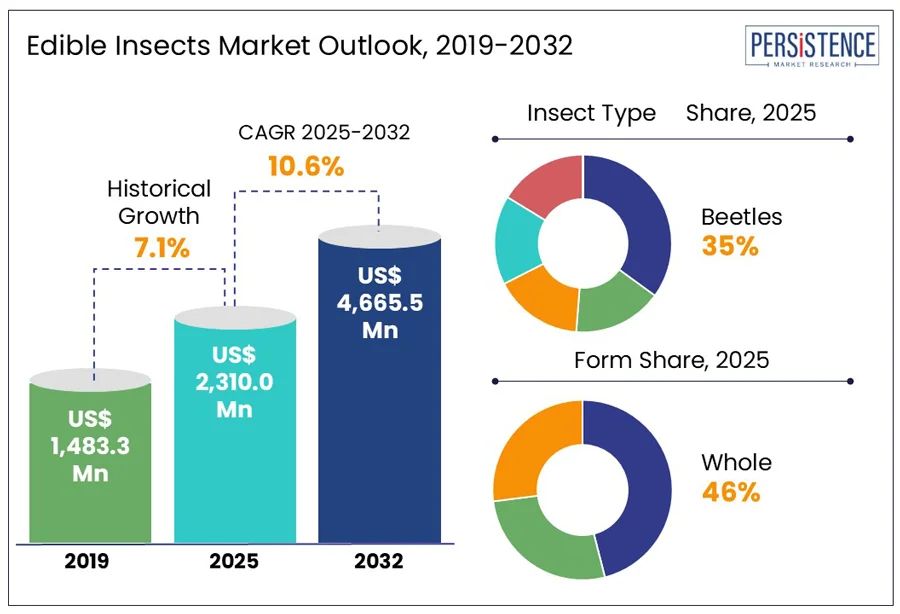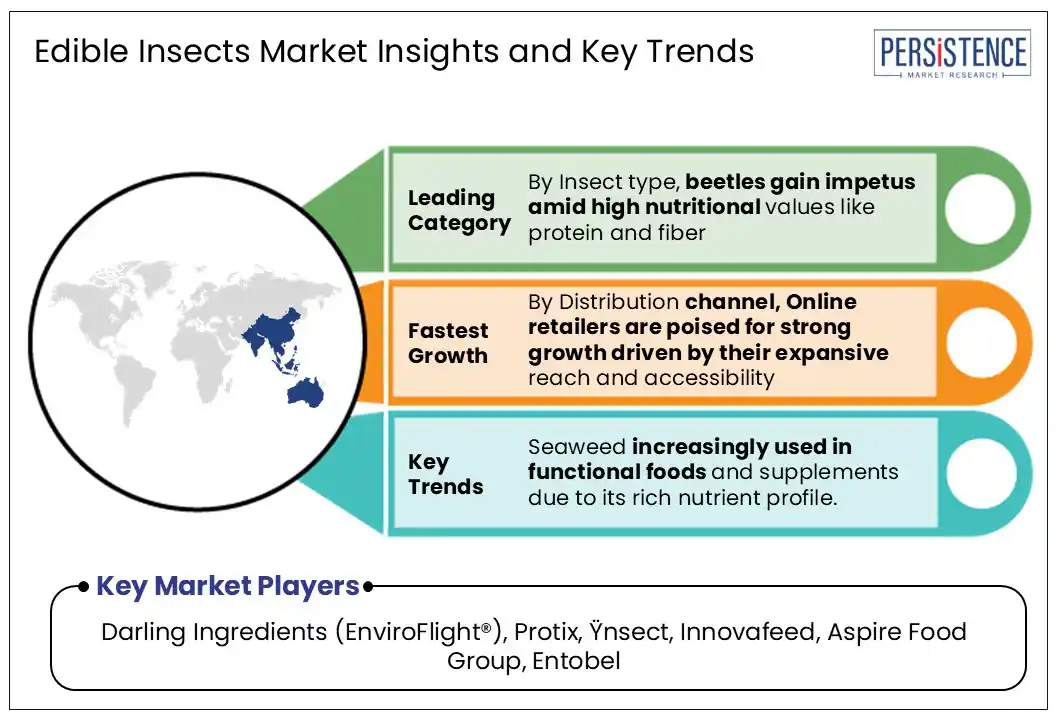ID: PMRREP11491| 186 Pages | 12 Jun 2025 | Format: PDF, Excel, PPT* | Food and Beverages

The global edible insects market size is estimated to grow from US$ 2,311.0 million in 2025 to US$ 4,665.5 million by 2032. The market is projected to record a CAGR of 10.6% during the forecast period from 2025 to 2032.
According to the Persistence Market Research report, the edible insects industry is poised for robust expansion, driven by increasing demand for sustainable protein and heightened awareness of environmental benefits. This growth is further propelled by technological advancements in farming and evolving consumer acceptance, positioning insects as a future key food source.

Key Industry Highlights:
|
Global Market Attribute |
Key Insights |
|
Global Edible Insects Market Size (2025E) |
US$ 2,311.0 Mn |
|
Market Value Forecast (2032F) |
US$ 4,665.5 Mn |
|
Projected Growth (CAGR 2025 to 2032) |
7.1% |
|
Historical Market Growth (CAGR 2019 to 2024) |
10.6% |
The edible insect business is experiencing a surge due to increased investments in commercial insect farming operations. Insects such as crickets and mealworms are recognized as sustainable protein sources, leading to heightened financial support for farming operations.
For instance, in September 2023, Protix, a leading agri-tech firm, invested nearly US$ 120 million in North America to expand insect farming operations and meet the growing demand for alternative protein sources. Similarly, in October 2023, FarmInsect, an Agtech startup, successfully raised a Series A financing round of US$ 8.8 million, led by Sandwater. The company plans to utilize its fresh capital to expand its sales activities and increase its production capacity.
Investments are directed toward infrastructure, advanced breeding techniques, and innovative feeding systems to improve efficiency and scalability in commercial insect farming. Automation and precision farming technologies are further enhancing cost-effectiveness and sustainability within the industry. The demand for edible insects is further driven by ongoing research, growing acceptance in various economies, and concerted efforts to reduce environmental impact. Concerns surrounding sustainable agriculture and global food security are expected to continue driving the growth of commercial insect farming.
The industry of edible insects faces considerable obstacles from the traditional meat and plant-based protein sectors, as customers in developed nations are less receptive to novel possibilities and prefer well-known substitutes. For instance, according to the Food and Agriculture Organization (FAO), by 2030, the world's meat consumption is expected to reach 45.3 kg per person, which will increase competition and make it harder for edible insects to gain market share or attract consumers.
Plant-based companies like Beyond Meat and Impossible Foods, which capitalize on advanced marketing techniques highlighting convenience, flavor, and nutrition, have strengthened customer devotion to traditional and plant-based proteins. The idea that eating insects is only done in underdeveloped nations and the misconception that they are pests turn off prospective customers in wealthy markets.
Insect producers worldwide are adopting advanced breeding methods, including IoT and other emerging technologies to enhance efficiency and profitability. For instance, in March 2019, Protix and Bühler Group partnered to use IoT and innovative breeding techniques to revolutionize insect farming by enhancing automation, monitoring, and data-driven decision-making in the process.
In insect farming, IoT integration improves growing conditions, temperature, and humidity, increasing output and product quality. Such a strategy ensures a steady supply, increases profitability, and broadens the market for edible insects. These technological advancements boost current operations, paving the way for the development of novel insect-based products, from sustainable animal feed to alternative protein sources for human consumption. This ongoing innovation promises to make insect farming a significant player in the global food system, addressing both environmental concerns and food security challenges.
The potential for edible insects to transform sustainable protein sources is influencing nutrition, and their adoption is being significantly fueled by endorsements from athletes and dietitians. Athletes, who symbolize peak health and performance, are promoting innovative dietary choices, effectively bridging the gap between traditional diets and edible insects, which boast exceptional nutritional profiles.
Crickets, for instance, are rich in protein, vitamins, minerals, and omega-3 fatty acids, making them ideal for athletes due to their high protein content. By sharing personal experiences and showcasing how insect-based products enhance performance, athletes are effectively promoting these foods on social media. Simultaneously, nutritionists are influencing public opinion by highlighting edible insects' health and environmental benefits. They are also collaborating with experts such as IPIFF to integrate insects as a key component of sustainable diets.
Beetles are set to emerge as a popular edible insect in the Western world, projected to capture an estimated 35% of the global edible insect market share by 2025.
Once a staple in Asian households, beetles are gaining popularity in Europe and North America due to their high nutritional value, including protein, fiber, and essential vitamins. The market is fueled by consumer awareness of sustainable food sources and their environmental benefits. For example, the European Food Safety Authority (EFSA) approved beetles as a novel food ingredient in 2023, driving adoption in products such as protein bars, snacks, and flour. Start-ups such as Ÿnsect have increased production capacity to meet the demand, while companies in the U.S. and Canada are experimenting with roasted and flavored beetle snacks. The beetle's appeal aligns with a broader shift toward eco-friendly diets, making them a cornerstone of the edible insect industry's expansion.
The whole form segment is poised to maintain its dominance, set to hold a market share of 46% in 2025. Consumers prefer convenient and versatile forms of insect-based products, which can be easily incorporated into a variety of food applications. The rise in health-conscious consumers, coupled with the growing awareness of the environmental benefits of edible insects, supports this segment's growth. Innovations in processing and packaging have made insect-based products more appealing, leading to higher adoption across different regions and demographics. This trend signifies a shift in consumer perception, as once-niche products become mainstream dietary staples. As research continues to highlight their nutritional density and ecological advantages, whole insects are increasingly seen as a viable and sustainable alternative to traditional protein sources, further cementing their market position. This evolving consumer acceptance suggests a robust future for whole insect consumption.

North America is expected to account for 15.3% of the global market share for edible insects in 2025. This growth is driven by the U.S.'s proactive approach to sustainable food alternatives and protein diversification. Increasing awareness of food waste, nutritional deficiencies, and the environmental impact of traditional livestock farming is leading to a shift toward insect-based solutions. In the U.S., mealworms and crickets are becoming popular as high-protein, low-fat substitutes. The FDA's updated guidelines in 2023 have reinforced food safety for insect products, enhancing consumer trust. U.S. startups are creating innovative cricket-based snacks and supplements, aligning with the nation's growing demand for environmentally friendly, nutrient-rich diets.
Major online platforms like Amazon and Walmart in the U.S. now offer a wide variety of insect-based products, from snacks to chocolates, indicating a rise in mainstream acceptance. Additionally, Canada's $8.5 million investment in Aspire's insect farming facility demonstrates a strong commitment to the industry in the region. Together, these trends are positioning North America, particularly the U.S., as a leading hub in the global edible insect protein movement.
The Europe region is envisioned to dominate the global edible insect industry, holding a value share of 31.4% by 2025. In the European edible insect market, consumer trust is promoted by the European Union's Novel Food Regulation (EU 2015/2283), which assures safety and uniformity for novel foods, including insects. A comprehensive pre-market authorization procedure, including the European Commission, EFSA, and EU Member States, is mandated under the legislation. Edible insects, a low-resource, environmentally friendly protein source, are gaining popularity in Europe due to advancements in agricultural technology, government financing, and institutional support. Leading countries like Belgium and the Netherlands are spearheading innovation in the production and consumption of edible insects.
The edible insects market is highly fragmented, characterized by the presence of numerous small and medium-sized enterprises (SMEs) and startups worldwide. As awareness increases regarding sustainable protein sources and nutrient-rich alternatives, competition in this market intensifies. There is a growing demand for organic edible insects, while industrial-scale insect farming is seeing increased investments in automation and advanced technologies. A notable example of innovation in this space is the U.S.-based brand Don Bugito, which celebrates food diversity and ancient culinary traditions, appealing to adventurous and eco-conscious consumers. Companies are distinguishing themselves through unique taste profiles, creative recipes, and a variety of product formats designed to cater to different dietary preferences. Efficient supply chains, inventive branding, and targeted marketing strategies are playing a crucial role in shaping this evolving market. Furthermore, many companies are actively collaborating with regulatory bodies to secure approvals and establish clear safety standards, paving the way for broader market acceptance.
The global edible insects market is projected to be valued at US$ 2,311.0 Mn in 2025.
Rising investments in commercial insect farming to scale up production drives demand for edible insects.
The global edible insects market is expected to witness a CAGR of 10.6% between 2025 and 2032.
Adoption of novel technology in insect farming presents a significant market opportunity for companies.
Major players in the Global Edible Insects market include Darling Ingredients (EnviroFlight®), Protix, Ÿnsect, Innovafeed, Aspire Food Group, Entobel, and others.
|
Report Attribute |
Details |
|
Historical Data/Actuals |
2019 - 2024 |
|
Forecast Period |
2025 - 2032 |
|
Market Analysis |
Value: US$ Mn |
|
Geographical Coverage |
|
|
Segmental Coverage |
|
|
Competitive Analysis |
|
|
Report Highlights |
|
|
Customization and Pricing |
Available upon request |
By Insect Type
By Form
By Distribution Channel
By Region
Delivery Timelines
For more information on this report and its delivery timelines please get in touch with our sales team.
About Author